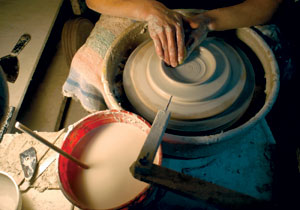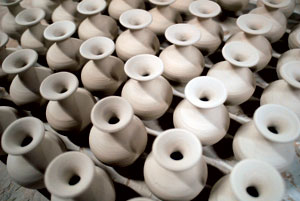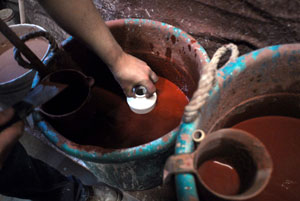WHITEFISH – Joseph Pesina makes 21 symmetrical clay mugs each morning to get warmed up. It takes him about 40 minutes.
Then he tackles his to-do list, which will keep his hands busy on the potter’s wheel for at least seven more hours at Whitefish Pottery’s ceramic studio, a bustling little workshop owned by Tom Gilfillan and nestled in the mountains five miles west of Whitefish.
Pesina, who is the studio’s production potter, hand-spins roughly 95 percent of all pottery that leaves the studio, Gilfillan said. Pesina is matter-of-fact when he talks about his role as ceramic guru.
“It’s just basically that I’m addicted to this stuff,” he said.
 |
|
Joseph Pesina drags his fingers across wet clay to produce a larger dish at Whitefish Pottery’s production studio. |
An hour spent inside the studio is a study in efficiency, role-playing and patience. While the ceramics start with Pesina’s work at the wheel, they are far from finished once they leave his hands. They face a long road that will take them through various drying processes, sanding sessions, kilns burning at 2,000 degrees or hotter, chemical glazes and the busy hands of three other employees – four if Gilfillan gets in on the act.
All told, the process to complete a single ceramic may take up to three or four weeks before it’s ready for display.
Gilfillan started Whitefish Pottery – both the studio and the downtown retail store – in 1995 after a long stint as a junior high school art teacher in Wisconsin. But by the time he moved to Whitefish his experience in pottery already stretched far beyond the walls of junior high school. Gilfillan earned his Master of Fine Arts degree from Penn State University and also worked as a production potter in Ohio.
 |
|
Mini pots are set aside before going into the kiln at Whitefish Pottery’s production studio. |
Now, 14 years after moving to Whitefish, Gilfillan is preparing for another annual anniversary celebration, which will include a 20 percent-off sale at the retail store from May 5 to May 10 and a customer appreciation party at the studio on May 8.
“We’re hoping for a good summer,” Gilfillan said.
The studio produces an array of handmade mugs, dishes, bowls and its emerging hot item – mini pots. On this particular day, the studio was getting ready to send out 288 mini pots to Rocky Mountain National Park. Gilfillan works frequently with national parks, having found good income in the gift shop business.
The complete process of preparing a mug, which starts with Pesina’s one- to two-minute job, is an apt example of the complex process that shapes a ceramic. After Pesina crafts the mug to meet specific dimensions, it is left to partially dry until apprentice Virginia Pfau attaches the handle. It then makes its way into an electric kiln burning at 1,800 degrees where it sits for about eight hours. Then it’s cooled for 30 or so hours until it’s hard and ready to be glazed. That’s when Tim Carlburg takes over.
 |
|
Tim Carlburg dips a piece of pottery into a glaze at Whitefish Pottery’s production studio. One of the difficulties of the glazes is keeping straight what colors will look like after they are fired, said Carlburg. White glaze is actually red and pink is actually black being two examples. |
Carlburg has an array of glaze recipes that look like the guidelines for a chemistry lab experiment. They all form different colors. Carlburg dips the ceramics into the glazes or sprays the concoctions on with a tool similar to a turkey baster, forming the patterns he desires. He tries to keep to the same pattern, much like Pesina makes each piece in a set identical.
Then Carlburg puts the ceramics into a propane kiln that burns even hotter than the electric kiln. There the glazes take on their full colors, ranging from radiant reds and oranges to dark purples and blues. The ceramics are removed from the kiln, cooled again and passed on to Dan Shephard to be packaged and readied for distribution.
Throughout the process, Gilfillan runs around, alternating between paperwork, phone calls and participation. He gets his hands dirty too.
“I’m everything from janitor to CEO,” Gilfillan said.